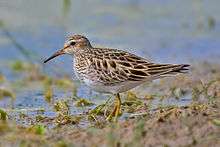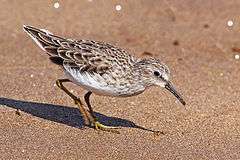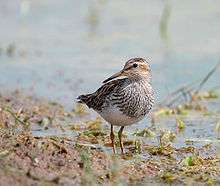Pectoral sandpiper
| Pectoral sandpiper | |
|---|---|
 | |
| Adult in breeding plumage | |
 | |
| Adult non-breeding | |
| Scientific classification | |
| Kingdom: | Animalia |
| Phylum: | Chordata |
| Class: | Aves |
| Subclass: | Neornithes |
| Infraclass: | Neognathae |
| Superorder: | Neoaves |
| Order: | Charadriiformes |
| Suborder: | Scolopaci |
| Family: | Scolopacidae |
| Genus: | Calidris (disputed) |
| Species: | C. melanotos |
| Binomial name | |
| Calidris melanotos Vieillot, 1819 | |
| Synonyms | |
|
Actodromas maculata | |
The pectoral sandpiper (Calidris melanotos) is a small, migratory wader that breeds in North America and Asia, wintering in South America and Oceania. It eats small invertebrates. Its nest, a hole scraped in the ground and with a thick lining, is deep enough to protect its four eggs from the cool breezes of its breeding grounds. The pectoral sandpiper is 21 cm (8.3 in) long, with a wingspan of 46 cm (18 in).
Taxonomy
The pectoral sandpiper is sometimes separated with the "stint" sandpipers in Erolia. This may or may not represent a good monophyletic group, depending on the placement of the phylogenetically enigmatic curlew sandpiper ("C." ferruginea), the type species of Erolia. In any case, the genus name Ereunetes—formerly used for the western sandpiper ("C." mauri) and semipalmated sandpiper ("C." pusilla), which are also members of the stint clade—was established before Erolia.
"Cox's sandpiper" ("Calidris" × paramelanotos) is a stereotyped hybrid between this species and the curlew sandpiper. This does not prove a particularly close relationship between these two species, as far more distantly related waders have successfully hybridized. In any case, among the stint clade the red-necked stint ("C." ruficollis) and the long-toed stint ("C." subminuta) are particularly close relatives of the pectoral sandpiper.[2]
The scientific name is from Ancient Greek. The genus name kalidris or skalidris, is a term used by Aristotle for some grey-coloured waterside birds. The specific melanotos is from melas, "black" and notos, "backed ".[3]
Description

This bird looks similar to the widely sympatric sharp-tailed sandpiper ("C." acuminata), which is not a member of the stint clade however. The pectoral sandpiper is a largish calidrid (21 cm (8.3 in) in length, with a wingspan of 46 cm (18 in))[4] with a grey-brown back, brownest in the summer male, and greyest in winter. The pectoral sandpiper has a grey breast, sharply demarcated at its lower edge, which gives this species its English name; this clear dividing line is particularly conspicuous if the birds are turned towards the observer. The legs are yellowish, and the bill is olive with a darker tip.
The juveniles are more brightly patterned above with rufous colouration and white mantle stripes.
This species differs from the sharp-tailed sandpiper in its breast pattern, weaker supercilium and greyer crown.
| Standard Measurements[5][6] | |
|---|---|
| length | 200–240 mm (8–9.6 in) |
| weight | 73 g (2.6 oz) |
| wingspan | 460 mm (18 in) |
| wing | 136–142.8 mm (5.35–5.62 in) |
| tail | 60.4–63.9 mm (2.38–2.52 in) |
| culmen | 28.7–29.3 mm (1.13–1.15 in) |
| tarsus | 27.8–30 mm (1.09–1.18 in) |
Distribution and ecology
It is a very long-distance migrant, and about half of the species breeds in the boggy tundra of northeast Asia, the rest nesting in a range from Alaska to central Canada.[7] The American and most of the Asian birds winter in South America, but some Asian breeders winter in southern and Australia and New Zealand. On migration and in winter, the pectoral sandpiper is typically found in freshwater habitats.
This species also occurs as a regular migrant to western Europe, and is seen most years in Ireland or Great Britain.[8] While the pectoral sandpiper has not been recorded as breeding species in Europe, vagrant individuals were found in Scotland in suitable breeding habitat during summer.[9] Many of the birds occurring in Western Europe may be on a regular migration from Asian breeding grounds to winter in Southern Africa.[10] September 2003 saw a record influx to those two countries, with 40 found in Ireland and 150 in Great Britain. On the US Pacific coast, such stagings of migrant flocks appear to be rarer.[11] Vagrant individuals are sometimes seen elsewhere off the usual migration routes, e.g. on the Marianas, the Marshall Islands and Palau in Micronesia; they are somewhat more frequently encountered on the Hawaiian Islands.[12][13][14]
The pectoral sandpiper's migration might be affected by global warming, as is suspected for many Arctic-breeding birds: 100 years ago, migrating pectoral sandpipers were observed to pass through northern Ohio in early-mid May and again in late August; today, the bulk of the northward migration takes place in April already, and most birds do not return until mid-September.[15][16]
These birds forage on grasslands and mudflats, picking up food by sight, sometimes by probing. They mainly eat arthropods and other invertebrates. The male has a courtship display which involves puffing up his breast, which has a fat sac in the breeding season to enhance his performance.
The pectoral sandpiper builds a steep-sided scrape nest with a considerable volume of lining material. The nest is deep enough that the eggs sit about 3 cm (1.2 in) below ground level, which helps to minimize heat loss from the cool breezes which occur at the latitudes where the species nests.[17] The female lays four eggs.
References
- ↑ BirdLife International (2012). "Calidris melanotos". IUCN Red List of Threatened Species. Version 2013.2. International Union for Conservation of Nature. Retrieved 26 November 2013.
- ↑ Thomas, Gavin H.; Wills, Matthew A.; Székely, Tamás (2004). "A supertree approach to shorebird phylogeny". BMC Evolutionary Biology. 4: 28. doi:10.1186/1471-2148-4-28. PMC 515296
 . PMID 15329156. Supplementary Material
. PMID 15329156. Supplementary Material - ↑ Jobling, James A (2010). The Helm Dictionary of Scientific Bird Names. London: Christopher Helm. pp. 84, 248. ISBN 978-1-4081-2501-4.
- ↑ Robinson, R.A. "Pectoral Sandpiper Calidris melanotos". BirdFacts: profiles of birds occurring in Britain & Ireland (BTO Research Report 407). Thetford: bto.org. Retrieved 9 August 2012.
- ↑ Godfrey, W. Earl (1966). The Birds of Canada. Ottawa: National Museum of Canada. p. 152.
- ↑ Sibley, David Allen (2000). The Sibley Guide to Birds. New York: Knopf. p. 184. ISBN 0-679-45122-6.
- ↑ "TAXON: Pectoral Sandpiper, Calidris melanotos". U.S. Geological Survey. Retrieved 9 August 2012.
- ↑ Harrison, Graham; Harrison, Janet (2005). The New Birds of the West Midlands. West Midland Bird Club. ISBN 0-9507881-2-0. Archived from the original on 23 January 2009.
- ↑ Vittery, Alan (1997). The Birds of Sutherland. Colin Baxter Photography. ISBN 1-900455-18-8.
- ↑ Lees, A.C.; Gilroy, J.G. (2004). "Pectoral Sandpipers in Europe: vagrancy patterns and the influx of 2003". British Birds. 97 (12): 638–646.
- ↑ For example the species was described as "unusual" in San Mateo County, California in the late 19th century, despite nearby San Francisco Bay offering excellent stopover habitat: Littlejohn, Chase (1916): Some unusual records for San Mateo County, California. Presentation at Cooper Club Northern Division Monthly Meeting, November 18, 1915. Abstract in "Minutes of Cooper Club Meeting" (PDF). Condor. 18 (1): 38–40. 1916. doi:10.2307/1362896.
- ↑ Wiles, Gary J.; Johnson, Nathan C.; de Cruz, Justine B.; Dutson, Guy; Camacho, Vicente A.; Kepler, Angela Kay; Vice, Daniel S.; Garrett, Kimball L.; Kessler, Curt C.; Pratt, H. Douglas (2004). "New and Noteworthy Bird Records for Micronesia, 1986–2003". Micronesica. 37 (1): 69–96.
- ↑ VanderWerf, Eric A. (2006). "Observations on the birds of Kwajalein Atoll, including six new species records for the Marshall Islands". Micronesica. 38 (2): 221–237.
- ↑ VanderWerf, Eric A.; Wiles, Gary J.; Marshall, Ann P.; Knecht, Melia (2006). "Observations of migrants and other birds in Palau, April–May 2005, including the first Micronesian record of a Richard's Pipit". Micronesica. 39 (1): 11–29.
- ↑ Henninger, W.F. (1906). "A preliminary list of the birds of Seneca County, Ohio" (PDF). Wilson Bulletin. 18 (2): 47–60.
- ↑ "Annotated Ohio state checklist" (PDF). Ohio Ornithological Society. 2004. Archived from the original (PDF) on 18 July 2004.
- ↑ Reid, J.M.; Cresswell, W.; Holt, S.; Mellanby, R.J.; Whitfield, D.P.; Ruxton, G.D. (2002). "Nest scrape design and clutch heat loss in Pectoral Sandpiper (Calidris melanotos)". Functional Ecology. 16 (3): 305–312. doi:10.1046/j.1365-2435.2002.00632.x.
Further reading
- Hayman, Peter; Marchant, John; Prater, Tony (1986). Shorebirds: an identification guide to the waders of the world. Boston: Houghton Mifflin. ISBN 0-395-60237-8.
External links
| Wikimedia Commons has media related to Calidris melanotos. |
| Wikispecies has information related to: Calidris melanotos |
- BirdLife species factsheet for Calidris melanotos
- "Calidris melanotos". Avibase.

- "Pectoral sandpiper media". Internet Bird Collection.
- Pectoral sandpiper photo gallery at VIREO (Drexel University)
- Interactive range map of Calidris melanotos at IUCN Red List maps
- Audio recordings of Pectoral sandpiper on Xeno-canto.
- Calidris melanotos in the Flickr: Field Guide Birds of the World
- Pectoral sandpiper media at ARKive

